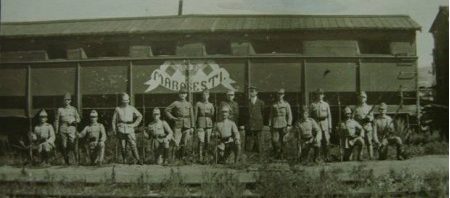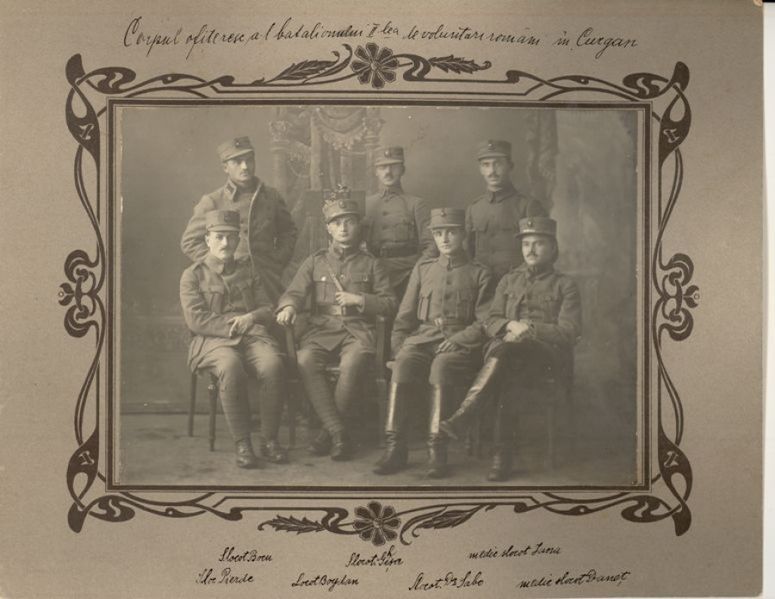
Introduction and Context
- The Two Revolutions
The following text is a short fragment of an eye-witness account of the 1917 Revolutions: Voicu Nițescu’s Twenty Months in Russian and Siberia published in Brașov (Romania) in 1926. The book, a rather long-winded work of three volumes, is not the work of an enthusiast: there is hardly any sympathy in it for the February Revolution, let alone Red October. One would search in vain for the heroic undertones of John Reed’s writings or for its stern fervour. For Nițescu, when not a dreadfully murderous enterprise, the Revolution was just a sure recipe for disaster. And his book is a careful, punctilious description, almost moralistic in its disapproval, of the upcoming catastrophe. Nițescu did have an understandable reason for his bias: as a member of the Romanian Volunteers Corps, he had actively fought, during the hazy atmosphere of the Russian Civil War, against the Red Army. The Corps, like the much more famous Czechoslovak Legion, had been an attempt to organize the Romanian POWs, scattered throughout Russia, into a volunteers’ army against the Central Powers.[1] Nițescu was heavily involved in its organization since its beginnings in 1917. The revolutionary, anti-war atmosphere in Russia complicated things beyond measure, however. Like similar military organizations (Polish, Serbian, Slovene), the Corps was forced to escape Russia through Vladivostok, entering into recurring conflicts with the Red Army.[2] Nițescu’s story is that of this long trek from Ukraine to the Pacific, in the midst of a raging Civil War: allied with the Czechoslovak Legion and aided by the French Military, the Romanians became enmeshed in various alliances with the Whites before finally returning to Romania in 1920.
One should make no bones out of it: Nițescu’s account is full of ideological admonitions and simplistic political rebukes. Throughout his wordy prose, he effortlessly bumps into any possible 19th century common-place about the “Russian soul”, its proclivity to political radicalism, or the dangers of socialism. His political and emotional distance towards the Revolution is practically unbridgeable. However, it is not ideological revulsion that determines his reservations: he is far from displaying the fierce, passionate anti-communism of other texts from the period. His anti-communism is not of a raging kind; it is almost natural, by default, a sign of social respectability. Even when falling prey, for instance, to common-place anti-socialist propaganda, Nițescu is too much of a connoisseur of the Russian context not to understand the social dynamics which led to the Revolutions. As he constantly hints at throughout the text, Lenin’s rise was the result of the late czarist period, rife with social violence and poverty.
His detachment derives from another source. Bluntly put, Nițescu lived in a different ideological imaginary, being engaged in a revolution of his own, one very different from what he was witnessing. For him, the end of the First World War also represented the demise of the Ancien Regime, of the “antiquated” empires of Eastern Europe. On this aspect he was of the same mind as the socialists around him. What this end announced was something else, however: not a socialist society, but the dawn of democratic national states. The revolution taking place in Nițescu’s world, determining his actions and his allegiance, his way of thinking, and even his daily habits, was a bourgeois national revolution. His heroes were Masaryk and Józef Pilsudski rather than Lenin and Rakovsky.
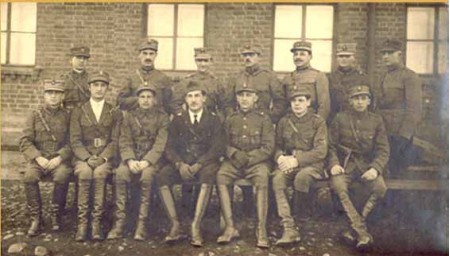 It is hard now to fathom emotionally the extent to which this contending revolution acted as an alternative to the socialist one. After all, the Polish-Soviet war, the situation in Ukraine and the Baltic States, the Romanian and Czechoslovak interventions in the Civil War, the Georgian and Finnish contexts were all moulded by the conflict between the two revolutions. It was Austro-Marxists like Otto Bauer who, witnessing the events in Prague, Helsinki, Vilnius, Riga, Warsaw, were most conscious of this conflict, constantly warning against understating the importance of nationalism for the post-war period. And while one can accuse the Austro-Marxists of a lot of things, their reading was not altogether groundless. In the end, what prevented the Russian Revolution from becoming a World Revolution was the concentrated effort of emerging national armies fighting against the Reds: the Baltic Countries, the Polish Army, the Romanian army violently crushing the Hungarian Republic of Councils.
It is hard now to fathom emotionally the extent to which this contending revolution acted as an alternative to the socialist one. After all, the Polish-Soviet war, the situation in Ukraine and the Baltic States, the Romanian and Czechoslovak interventions in the Civil War, the Georgian and Finnish contexts were all moulded by the conflict between the two revolutions. It was Austro-Marxists like Otto Bauer who, witnessing the events in Prague, Helsinki, Vilnius, Riga, Warsaw, were most conscious of this conflict, constantly warning against understating the importance of nationalism for the post-war period. And while one can accuse the Austro-Marxists of a lot of things, their reading was not altogether groundless. In the end, what prevented the Russian Revolution from becoming a World Revolution was the concentrated effort of emerging national armies fighting against the Reds: the Baltic Countries, the Polish Army, the Romanian army violently crushing the Hungarian Republic of Councils.
- The Long Cold War and those Endless Meetings
Nițescu’s trip to Russia became an exercise in ideological voyeurism: these are the travels of a sure-footed bourgeois nationalist observing, with a reserved curiosity, the “oddities” of communism and Russia. There are at least three reasons why such a voyeuristic exercise should catch our curiosity. First, Nițescu’s book is much more than an account of his eventful journey. It represents a specific genre of writings on Soviet Russia, a genre central for the history of interwar Eastern and Central Europe. Most of them are eye-witness accounts, written by POWs or former soldiers from Poland, Romania, Czechoslovakia, Hungary; people who willy-nilly found themselves in the midst of the revolutionary events. In a lot of ways, these accounts were a form of Cold War literature, although a Cold War which we easily tend to forget, that of the interwar period. As Alexander Anievas[3] remarked, it was during the 1920s that, for the first time in history, capitalism was seen as unstable enough to collapse. Suddenly, the world was perceived as divided between capitalism and socialism. After all, the 1917-1921 period had witnessed the largest revolutionary movement in history: from Ireland to Siberia, the world was on fire and the spectre of communism never seemed more present.
For the countries of Eastern Europe, part of Clemenceau’s Cordon Sanitaire and founded as bulwarks of anti-communism, this Cold War took on impressive proportions. The level of anti-socialist witch-hunt reached awe-inspiring levels: from direct police repression to a new anti-communist discourse which dominated the public sphere for decades. Books such as Nițescu’s were part and parcel of these battles. They were to provide information about an ideological other which, although living across the border, was moving and breathing in a different world. The Revolutions and the Civil War had made the Soviet Union a terra incognita, whose sheer inaccessibility created a gigantic space for ideological fantasies. In countries like Romania, the memory of the 1917 Revolutions was handed down through this genre of writings rather than John Reed’s Ten Days That Shook the World (1919). They were the accounts which shaped public opinion about Russia, influencing how the young Soviet state was perceived. This is not to say that in Eastern Europe the memory of the Revolution was devoid of any sympathetic accounts. These could be found, however, solely in small proletarian public spheres, as radicalized as they were harassed by the state and the newly created secret police. Exceptions, such as Czechoslovakia and Vienna, only confirmed the general rule of a public sphere incensed and dominated by Red Scare tropes. One cannot fail to recognize in this pre-1945 cold war a pre-history of today’s anticommunism. After 1989 Eastern European intellectuals would easily indulge in their passion for the interwar period, making it the centre-piece of the cultural canon. They found in it not just budding moments of literary modernism, but also the pre-made ingredients of an anti-communist discourse which is still pervasive today, from Riga to Sofia.
A second reason for unearthing Nițescu’s text is a specific tension underpinning it and what this can tell us about the Revolution. Nițescu’s nationalism is almost ontological: without a national idea, any state project seems doomed to him. And yet, the story he tells is totally different: from Ukraine to Vladivostok he witnessed a variety of state projects, some national, some socialist, some anarchist, some simple warlord-run power-centres. For a short period, from Berlin to the Pacific, Eurasia was an experimental ground, with state entities emerging and vanishing in a matter of months, competing for different resources in a war-torn context: from food to guns and public legitimation. Most of these projects failed, a few succeeded, as if for no apparent reason. The history of the Revolution is also the history of a violent period of vying state projects, of a continent in constant commotion. And yet the Socialist imaginary of the revolution has remained incredibly static, confined to a few punctual events in Petrograd, Budapest or Kiev, rather than the ups-and-downs of these fleeting post-war states.
Last but not least, the reason for choosing these specific passages is to convey another aspect, one which comes almost unwittingly, against Nițescu’s intentions. Throughout his text, a constant theme resurfaces again and again: whether in Kiev, Moscow or a small Ukrainian village, he notices a constant desire to talk, discuss, and debate collectively. Organized in workers’ councils’ or ad-hoc committees, peasants and workers are eager, at any moment, to open up a debate, to broach a discussion, to express themselves, in almost every possible context. At one point during the trip, while waiting in an isolated train station, Nițescu sees how the Russian crowd organize themselves in a committee, nominate their representatives and, in a jiffy, are ready to officially greet the Romanian foreigners so that they would not feel unwelcome. In front of the Romanians’ bewildered eyes, almost any congregation of people could transform itself into a committee.
Nițescu is constantly complaining about these endless meetings. Following a standard classist imaginary, he is ready to brand this discursive urge, this new passion for public gatherings the antithesis of work and order. Workers and peasants, talking all day, were simply loafing their way around, as work-shy irresponsible actors, forgetting about their duties and obligations. Instead of producing they were “doing politics”. Despite his ostensible attachment to democracy, Nițescu cannot help but see this as a chaotic reversal of social order: suddenly in Russia everybody talked and voiced their ideas—women, kids, workers, Jews. What bewildered Nițescu was a radical exercise in democracy, suddenly seeping in through the streets of the Empire, becoming the everyday reality of millions of people. Those who were supposed to keep quiet suddenly talked. And maybe this is what the Revolution was all about.
Twenty Months in Russia and Siberia [4]
At the Yuzovka Central Soviet[5]
A numerous working class resides in the Yuzovka region,[6] a highly industrialized area, together with the Ekaterinoslav gubernia surrounding it. Following the Petrograd model and their indications, the workers had already organized into central and regional soviets. The so-called Central Soviet for Deputies, Workers, Soldiers and Peasants was headquartered in Yuzovka, although the peasants, however, never actually had any representatives. Besides the Central Soviet, each plant, factory, enterprise or even farm featured a regional soviet, formally called a “workers’ council”. The bourgeois management had lost most of its power and influence after the first soviets were created; and very quickly the councils became the only institution capable of administrating the industrial enterprises. They would not confine themselves, however, to administrative or economic issues, keen as they were on doing politics and, actually, nothing but politics. Following the secret orders and the professional agitators sent by the Petrograd Central Soviet, they were enemies of war and advocates for peace; so they could not see our efforts in a favourable light. The Yuzovka Soviet was actually ready to take direct action against us: an order forbade us from reaching any volunteers in the surrounding factories and plants. Our protests had no effect. […] Finding ourselves suddenly unable to achieve our aims, the Romanian delegation asked for a meeting with the Central Soviet, to explain our point of view and our mission in Russia. On the 5th of July 197 (18 Old Style), we presented ourselves at the Soviet’s headquarters.
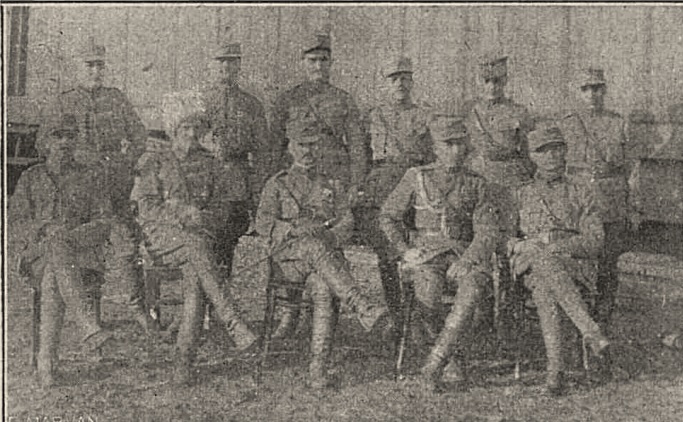
Over one hundred workers were inside the gigantic hall: most of them were debating while cracking sunflower seeds. Once the Romanian officers entered, silence ensued: all eyes were set on these exotic figures as if no one knew precisely whether they were humans or aliens. The meeting was presided by a hairy character, with thick eye-brows, dishevelled hair and a moustache gradually disappearing into a beard which looked more like a bunch of thistles. […] When the conversation between us and the predsedatel’ [chairman][7] of the committee started, there fell a deep silence on the meeting hall. “The comrades”, sun-flower seeds between their lips, were ready to swallow them rather than toss them on the floor, fearful of breaking the silence and missing the important dialogue. The predsedatel’ told us that the Soviet was against conscripting any POW and, while waiting for an explicit reply from Kerensky, whom he had notified, nothing could be done. The members of the Romanian delegation decided to show him the documents legitimizing their mission. Scuttling around the table, everybody in the hall was eager to see them. The predsedatel’ showed himself convinced of the legitimacy of our mission, but his Semitic smartness was not defeated yet.
“Taking any prisoners from the factories is a diplomatic problem” he uttered in a grave voice.
All “comrades” inside the hall, opponents of our mission, let go a sigh of relief, pleased with the predsedatel’ s way of presenting the issue, his new verbal trick. In a calm voice, the Romanian delegation retorted that this issue was also solved: among the documents one could read that an agreement had already been signed between the Russian and the Romanian governments. The comrades were baffled. The predsedatel’ shook his mane furiously, wiped his narrow forehead and frowningly tried again to save face in front of the comrades:
“But the Romanian Parliament has no right to take Austrian prisoners.” Every comrade’s eyes suddenly lit up as if facing a miracle and everyone began to stare at the Romanian officers, as if saying “Now, let’s be honest, there’s no way out of this!”. But this was just a fleeting illusion. The Romanian delegation went on to explain to the assembly that they were not talking about prisoners, but about volunteers, endowed with free-will. And, apart from that, the Russian comrades had already fought for their svoboda [freedom]: it’s hard to believe they could be against those comrades who were also fighting for the same thing, even if they spoke another language. After all, they simply wanted to be as free as the Russian people, svoboda.
Once these words were uttered, any resolve shattered; their hearts, directly targeted, were reeling, ready to give up. The only one who remained untouched was the predsedatel’, not that preoccupied with svoboda. […]
*
* *
More than anything else, it was the belief that we might want to prolong the war which was inciting the Soviets against the Romanian delegation; or better put, it incited their leaders, their professional agitators. The idea of peace was like a disease which had spread everywhere. And the extremists, manipulated by Lenin, Trotsky, Zinoviev and the others, were very keen on employing this disease to their advantage. Even the Galician offensive, organized through so many struggles, and the Halych successes[8] were perceived as bodging the plans of these secret agents of defeatism. They were working to transform this promising beginning into a total debacle.
For weeks on end, Lenin, who had come to revolutionary Russia through Germany, and Trotsky, expelled from France and the US, had been agitating amongst the ignorant masses, asking to halt any offensive and to bring about immediate peace. They were also fomenting against the pro-war Provisional Government, promoting the idea of a proletarian dictatorship, demanding power for the communist masses. Their partisans who – knowingly or not – served Prussian militarism, were mystified by these chimeras: they were spreading the communist gospel not only in Petrograd but also in the provinces, trying to install anarchy in the cities, in the countryside and especially within the army’s ranks. When they had a chance, their leaders did not hesitate to take it. In July 1917 the Red Guards, part of the Executive Committee of the Soviets, and helped by the Machine-gun Regiment of the Petrograd Garrison and other troops, rose up against the Provisional Government […] Happily, since this rebellion was badly organized and it lacked united leadership, the Maximalists, also called Bolsheviks, could not achieve their plans of toppling the government and taking power.[9] […]
As one might expect, the Southern mining region[10] was also on fire after the Petrograd events. There were countless stories circulating, with numerous details and, for a period, the false rumours that the Provisional Government has been arrested and Kerensky killed put the Maximalists in charge, while workers began to behave incredibly brazenly. The thought of taking over the factories and ousting the owners and the management was on everyone’s mind. A seething rage and a desire for vengeance could be noticed whenever the word “bourgeois” was mentioned.
The call for peace – mir – regardless of its price, along with the old slogans of revolutionary secret societies – zemlia i volia (land and freedom) – were voiced with increased fanaticism. The workers’ councils, transformed into soviets, were doubling their ranks with saboteurs (loafers) who wanted to replace the hard-work and the sufferings undergone until then with a perpetual state of laziness. POWs and former owners were put to work inside the factories and the pits, replacing the workers. All these loafers, wasting their time in committees, listening to never-ending meetings, playing the “commissars” or “militiamen”, were asking for regular pay from their employers. […] The peasants were repeatedly advised to stop working for the landowners, and to take hold of their properties. The freedom to confiscate private assets for the benefit of the numerous and the powerful was proclaimed an indisputable right.
*
* *
My friend C. informed me that an order from Bakhmut[11] had arrived, advising us to return to Yuzovka, where a new task for the Romanian Delegation would be drafted; our initial idea of going to Kursk had to be abandoned. […]
We went to the nearest train station and, with the help of our faithful N.P., we began the return-trip to Yuzovka. Russian trains at that moment were like live newspapers, a constant source of information. As train classes had been abolished, ticket control also disappeared and the passengers (bourgeois and workers, rich and poor, city-dwellers and peasants), were compelled to travel together, squeezed into the same space. In this travelling newspaper one could find all sorts of views, clashing ideas, opinions from all parties and ideological streams: pro-peace revolutionaries, anarchists, monarchists. […] A passenger, who appeared more like a foreigner, was struggling to speak Russian and mentioned that at least there was order in the old regime. Suddenly all revolutionaries felt attacked and started responding fiercely, in an avalanche of words and arguments, trying to show that “this is the true order, that of today”. A professor intervened: in his opinion, the Russian people were not yet ripe for so much freedom. Next, a lawyer voiced his idea that a constitutional monarchy would better fit the character, traits and cultural level of the Russian people. Both were violently rebutted by the train’s “public opinion”.
*
* *
Galitsinovka
We entered Galitsinovka[12] after a three-hour trip and from the first moment, we were greatly impressed: beautifully arranged stone houses with tiled roofs, large courtyards, barns ripe with the bounties of the fields; everything bespoke the wealth and the prosperity of the community.
We arrived at the village centre, which was a huge meadow, and stopping by the village hall we ran into a huge crowd, eagerly awaiting us, in a carnival-like atmosphere, impatient to hear about the purpose of our visit. As in other places people thought we were avstriytsy [Austrians], but some were saying we could be Serbs or even French.
The villagers in Galitsinovka had already organized themselves on a “revolutionary basis”. They had dismantled the old village-hall organization, electing a soviet committee with the role of representing the narod. The president of the committee, an agreeable, pleasant mujik, well above 50, greeted us politely and, after hearing the purpose of our visit, ordered to bring the prisoners to the village. The task was given to the “commissar”, a spritely young man, with the martial bearing of a Cossack, keen on preserving his soldierly demeanour, perfectly self-controlled. In an instant the commissar mounted a swift horse and disappeared to fulfil the predsedateli’s order, followed by a storm of dust.
While waiting for him, we were invited into the village hall to attend the committee session and the debate within the narod. The villagers were discussing the agrarian question. On everyone’s face there was an expression of spiritual transfiguration. They were hoping for a historical change, for something special to befall them, freeing them from the labourer’s toil so that they could be could remain happy forever. They were debating land distribution, but without mentioning any nitty-gritty details.
After a two-hour rush the commissar had managed to bring together the POWs who had been scattered either on the fields or in the villager’s households. The meeting was held on the village’s meadow (where the cows and the sheep were grazing) and, besides the village’s committee, the entire village was present, men, women, children. After the speeches explaining the situation, some members of the narod insisted on expressing their opinion regarding our call for volunteers.
A glib-tongued old lady, more of a chatterbox, told us jokingly:
“The avstriytsy [Austrians] are ours. We’ll not give them to you. You took our men, and now you want to take our prisoners?”
The young women, to whom the words were actually addressed, approved the intervention with an enthusiastic racket. A second mujika intervened as well:
“We just want peace, we’re tired of war, send our men back!”
A third one shouted: “We’ll give you the avstriytsy, but set our men free!”
An old man asked the women to keep quiet, so that he might state his ideas:
“Ever since Russia god rid of the Czar, the narod does not want to wage war anymore. But you still have a Czar so you’re forced to fight. You might argue and say that those countries that still have czars are more powerful. But do as you please, I only ask you to strive to bring peace faster, as soon as possible; since otherwise the narods of the world will simply die of hunger.”
All photographs picture the Romanian Volunteer contingent in Russia, 1917. They were first published in: Nițescu, Voicu. Twenty Months in Russian and Siberia. Brașov (Romania): 1926.
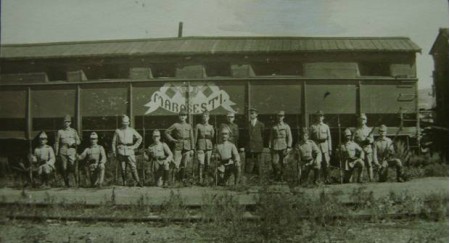
[1] Nițescu and the Romanian delegation visited the region of Donbass in 1917, before the October Revolution. Their agreement with the Provisional Government allowed them to select volunteers for the Romanian Corps. The Soviets’ reluctance to let that happened also sprang from their relative autonomy from the Provisional Government.
[2] Most of the volunteers were ethnic Romanians who, as Austro-Hungarian soldiers, had been captured by the Russian forces. Following the pressures of the Romanian state the Provisional Government had agreed to reorganize them into a division of volunteers to be deployed against the Central Powers.
[3] After the October Revolution, it became clear that the Romanian Corps and the Soviets did not see eye to eye. The volunteers’ intentions to continue the war ran totally against the Brest-Litovsk peace treaty with Germany. For the Romanians, on the other hand, the Bolsheviks seemed nothing but Germany’s pawns: with Bucharest under German occupation, peace prospects did not sound that gleeful. The tension rose high enough to reach a state of war, with Romania being officially in conflict with the Red Army. In these rather strained circumstances, the Romanian Corps found themselves in a curious situation: stuck on Russian soil, in a hostile setting, it was impossible to return to Romania directly. Their road had been cut off by the German forces and their allies; hence the Vladivostok solution.
[4] Alexander Anievas, Capital: Class Conflict and Geopolitics in the Thirty Years’ Crisis, 1914-1945. (University of Michigan Press, 2014).
[5] Translated from Voicu Nițescu: Douăzeci de luni în Rusia și Siberia, Anul 1917, Vol. 1, 2, 3, Brașov, Tipografia A. Mureșanu-Brănicescu, 1926.
[6] Nițescu and the Romanian delegation visited the region of Donbass in 1917, before the October Revolution. Their agreement with the Provisional Government allowed them to select volunteers for the Romanian Corps. The Soviets’ reluctance to let that happened also sprang from their relative autonomy from the Provisional Government.
[7] This is the pre-revolutionary name of Donetsk, in the Donbass region, named after the Welsh industrialist John Hughes who built the steel factory around which the city developed.
[8] In Russian in the original.
[9] In English is this is known as the Kerensky or the July Offensive. It started on July 1st 1917 and it was the last Russian attack on Austro-Hungarian and German troops before the Brest-Litovsk Peace Treaty (March 1918). Aided by the Romanian troops, the initial success of the attack was soon halted by the German and Austro-Hungarian armies, leading to a gigantic crisis for the Russian Stavka and the Provisional Government.
[10] These events are usually known as the July Days, when members of the Petrograd army started a spontaneous action against the Provisional Government. Contrary to what Nițescu mentions, the protests were influenced by anarchist groups rather than the Bolsheviks; initially the Bolsheviks were taken by surprise by the events, deciding however to support them and provide leadership. After the protests, important members of their leadership (Trotsky, Kamenev, and Lunacharsky) were accused of collaborating with the Germans and were arrested, while Lenin went into hiding in Finland. For more information see Alexander Rabinowitch. Prelude to Revolution: The Petrograd Bolsheviks and the July 1917 Uprising (Indiana UP, 1991)
[11] Nițescu refers to today’s Donbass region.
[12] A medium-sized city in the Donbas region.
[13] A village in the same region of Ukraine.

